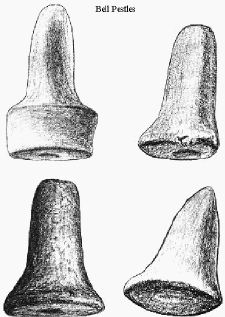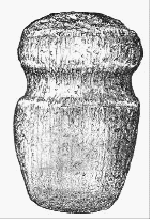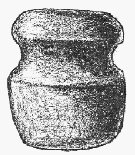|
About
the Hopewell
The Hopewells developed a more sophisticated community structure that
included different levels of importance/authority in order to enhance their society;
implement effective agricultural methods to farm the land (they were the first to do this), and improve hunting capability
and results. With centralized forms of community government, they could bring together
large numbers of people to work on important construction projects, such as major mounds
and fortifications.
Groups within the culture created their own marketable products from local resources,
either grown or mined from the earth. These items were then traded or sold to other groups
within the Hopewell area of influence. The information we have about the Hopewells has
been gleaned from the discovery of many of these artifacts.
Many sites in Ohio have produced treasured artifacts. In Shelby County these finds
include points (arrowheads and spearheads) made from flint and chert, tools, pestles (used
to grind grains), and jewelry. Rotted wood can tell an archeologist the location of houses
or villages while seeds of corn, beans, squash and pumpkins in waste pits illustrate their
agricultural practices.
Pottery is one of the most important items for studying prehistoric people because it
lasts for thousands of years and can be reassembled after it’s broken. Distinctive
decorating can help identify how people from one place traded with another.
The full grooved axes at right range from three inches to those weighing several
pounds. Made mostly from granatic stone of glacial origin, some slate or hematite was also
used. Various bell pestles are shown below.

|

Mound
City is located on the west bank of the Scioto River four miles north of Chillicothe,
Ohio. According to Robert Converse, Mound City, along with the Hopewell Farm, are the only
sites of their kind. This is a copy of his drawing that appeared in the fall, 1993, issue
of "Ohio Archeologist." |

|
|

|
Artifacts, Tools and Mounds
Indian Art
An important piece of Indian art known as a Popeyed birdstone was
found in 1935 in Franklin Township of Shelby County, Ohio. It is now in the collection of
a Sidney resident and Indian artifact collector, Ron Helman.
Artifacts
Other Ohio sites have produced a multitude of artifacts, including
axes, works of art, and stone pendants worn as adornments. An effigy pipe is a pottery handicraft that was used for
smoking tobacco and resembled real creatures. They were made from what is called Ohio pipe
stone, a clay found in the Scioto River valley that can be easily carved and baked.
Tools
The most important tools were made from flint and bones. Large
pieces of flint could be used to cut down small trees and strip bark from large ones.
Sharp flint pieces were tied to sticks to make arrows or
attached to long sticks to make spears for hunting. The Indians had a number of Ohio sites
where flint was mined to create points. In Logan County, a stone material known as
"chert" was also mined to produce points.
Mound Builders
The average height for Hopewell males in Ohio was 5 feet 9
inches. Both the Adena and the Hopewell (‘Mound Builders’) left us a legacy of
Indian mounds that are today considered treasures of the past.
Mounds located near Shelby County, Ohio, include the Miamisburg Mound and a mound
located on Johnston Farm in Piqua.
The Johnston Farm earthworks are believed to have been constructed by the Adena people
about two thousand years ago for ceremonial purposes. It is intact and can be viewed by
museum visitors today.
The Miamisburg Mound is the largest conical
burial mound in the state of Ohio and possibly in the eastern U. S. Archaeological
investigations of the surrounding area suggest that it was constructed by the prehistoric
Adena Indians. Built on a 100-foot-high bluff, the mound measures 877 feet in
circumference. It was originally more than 70 feet high.
Other
important mounds in Ohio include the Serpent
Mound, one of the few effigy mounds in the state, it is also the largest and finest
serpent effigy in the United States. Nearly a quarter of a mile long, Serpent Mound
apparently represents an uncoiling serpent. Moundbuilders State Memorial preserves the
Great Circle earthwork built by the Hopewell culture approximately 2,000 years ago. It is
one part of the Newark Earthworks which was the largest system of connected geometric
earthworks built anywhere in the world.
Fort Ancient features 18,000
feet of earthen walls built 2,000 years ago by Indians who used the shoulder blades of
deer, split elk antler, clam shell hoes and digging sticks to dig the dirt. At 3 1/2 miles
long, it is the longest prehistoric mound in the United States. The Ohio Historical
Society operates a museum at this site which tells the Indian story from prehistoric times
to modern day.
Although not a ‘mound’, important excavation work is underway at
Dayton’s Sunwatch Village which has thus far uncovered evidence of 23 Indian lodges
on its five acres of ground.
Some authentic mounds have been found in Shelby County, while other geologic formations
in our county have been inadvertently ascribed as mounds. As the current second millennium
A.D. began, the Hopewells gradually disappeared from Ohio, leaving it devoid of
habitation; but, in areas throughout much of the eastern United States and the Midwest,
they were replaced by the Mississippi Culture. This culture was an even more advanced
society that constructed immense mounds requiring the movement of up to one million cubic
yards of soil. These mounds took as much as five million man-hours to complete.
'Indian' segment written in December, 1997 by David Lodge
[ Back to Indians Index ]
|

